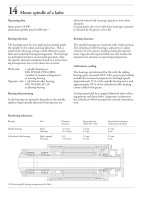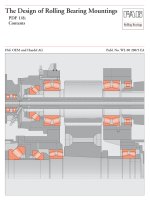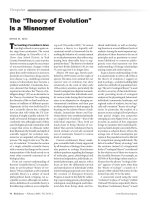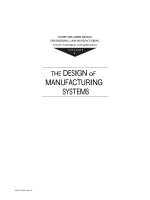The design of everyday things
Bạn đang xem bản rút gọn của tài liệu. Xem và tải ngay bản đầy đủ của tài liệu tại đây (4.78 MB, 43 trang )
User Interface Design and Programming
CS422
Luc Renambot
The Design of Everyday Things
Week 1
Homework
The purpose of this assignment is to give you a bit of practice with the material
presented in the first week of the class - the design of everyday things.
* find a vending machine on campus or surrounding
* note down where it is located and what kind of machine it is (pop, coffee,
snack, postage stamps, DVD, CTA, etc)
* think about how the user interacts with the vending machine.
o How does the machine present its capabilities to the user?
o What can the user do?
o What affordances does the machine present?
o How does the user know what to do first?
o What kind of feedback does the vending machine give to tell the user
about its state?
Homework
* draw a 1 page sketch (by hand, no photography allowed) of
the vending machine, stressing the user interface details (what
does the user see, what can the user press, what is the
mapping, etc)
* redraw the sketch using a computer and make a printout of
it (no scanning allowed)
* type a 1 page (8.5 x 11", 10 point font, single spaced)
discussion of what is good and what is bad about the interface.
Be sure to include your name at the top, and the information on
the vending machine itself.
Turn in your sketch, the redrawn version, and the 1 page
discussion, stapled together.
Course
•
First we will look at good and bad design in
general, independent of computer programs.
•
We will look at how to effectively present
information spending most of the course
looking at how to effectively design interfaces.
•
We will finally look at how to perform
evaluation of these traditional interfaces and
look at specific case studies.
Plan for Coming Weeks
•
Introduction & Design of Everyday Things
•
Information Exploration & Presentation Styles
•
Principles & Golden Rules
•
Interaction Devices & Direct Manipulation
Design of Everyday Things
•
It examines the effect of
poor design and
equipment failure on
human behavior
•
It covers user-centered
design, on everyday things
and on everyday actions
Design of Everyday Things
•
“I just found a Norman
door: It was really difficult
to open”
•
“Science Finds, Industry
Applies, Man Conforms”
•
1933 Chicago World's Fair
•
More about assimilation
Look around you
•
Start by looking at Interfaces for
•
Doors, Windows
•
Stove
•
Projectors
•
DVD players
Affordances
•
Perceived and actual properties of a thing,
primarily those fundamental properties that
determine just how the thing could possibly be used
•
Affordances provide strong clues to the operation of
a thing
•
Knobs are for turning
•
Slots are for inserting things into
•
Provide a good conceptual model and make things
visible
Example: Door
Example: Door
•
The designer's conceptual model
•
The user's conceptual model
System Image
•
The system image is the visible part of a
device (including the physical structure, the
documentation, instructions, etc)
•
The designer only talks to the user through the
system image
•
If the system image doesn't make the design
model clear, then the user will create a
different model through their interaction.
Mental Model
•
Conceptual model of the way
something works
•
Often constructed from fragmentary
evidence
Example: Thermostat
•
Will a room or oven heat (or cool)
faster if the thermostat is turned all
the way to the maximum setting?
Thermostat
•
Two 'folk' theories of thermostats
•
timer theory - thermostat controls the relative
proportion of time that the device stays on
•
valve theory - thermostat controls how much
heat (cold) comes out of the device
Thermostat
•
Both are wrong
•
Thermostat is an on/off switch
•
Fully on or fully off - no in between
•
Design gives no hint to the actual model
•
User's form their own theories
Automobile
•
Why is the basic automobile easy to figure out?
•
Things are visible
•
Good mappings between controls and things
controlled
•
Single controls have single functions
•
at least for driving - the radio is another story
•
Good feedback - immediate and obvious effect
Mapping
•
Relationship between controls and their affects
•
Want the mapping to be 'natural'
•
taking advantage of physical analogies and cultural
standards.
•
Steering wheel
•
Digital alarm clocks
•
Stove burners
•
Light switches
Connector
Connector
Home Examples
•
No writeups on the appliances
•
Trial and error
•
Light switches
Home Examples
Home Examples
light switch for fan/lights









